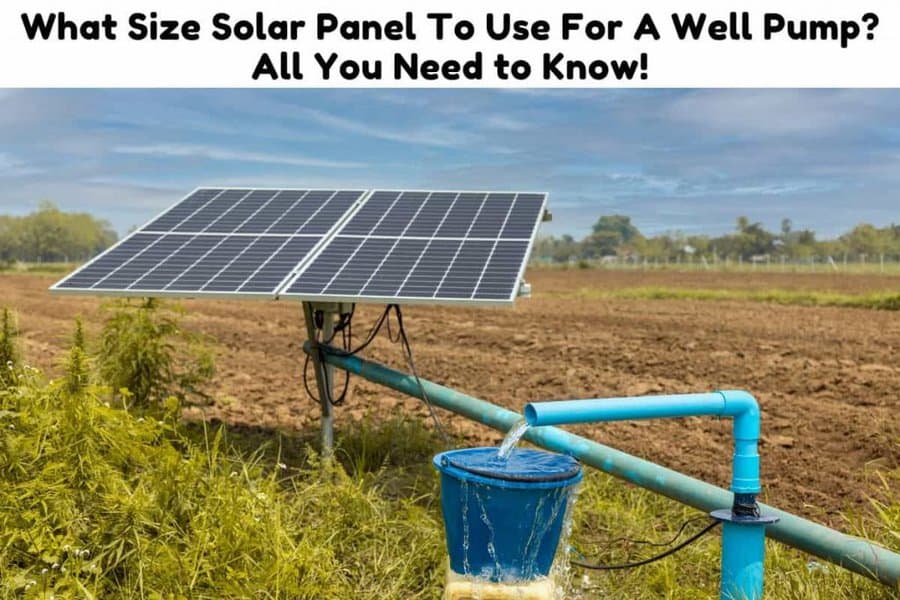Invented in the early third century BC, the Egyptian screw is one of the earliest devices used to move water from one place to another. Powered by kinetic energy like wind, cattle, or by hand, it’s considered one of the greatest inventions of all time, and is the basis of modern hydraulics.
Today, well pumps are electrically powered. Solar panels are an increasingly popular way to generate the electricity needed to run a well pump as it’s much cheaper than grid-supplied electricity.
But how many solar panels does it take to run a well pump? In this guide, we look at how to run a water pump using solar panels.

How Much Power Does A Well Pump Use?
It takes anywhere from 750 watts right up to 16,000 watts to run a well pump. The number varies depending on the size of the motor in the pump. The size of the motor is typically stated in horsepower. A 1 horsepower motor has a running wattage of 745.7 watts.
On a side note! If you’re in need of a reliable and high-performance portable solar panel, We strongly recommend the Jackery SolarSaga 100W Portable Solar Panel (Amazon Link).
With a high conversion efficiency and foldable design, this solar panel is easy to transport and set up, making it perfect for outdoor activities like camping, hiking, and RV trips.

The US solar cell technology used in this panel ensures that you get the most efficient and reliable solar charging possible.
There is also a 60W option that is more affordable (Amazon Link)
Well pumps use a motor to draw water. The power used by a motor is given in horsepower or HP and 1 HP is 745.7 watts or 0.75 kilowatts. But motors use starting power and running power.
Electric motors like those you find in air conditioning units, refrigerators, and well pumps need more power to start up. The starting power of an electric motor can be as much as double the running power.
| MOTOR SIZE (HORSEPOWER) | STARTING POWER (WATTS) | RUNNING POWER (WATTS) |
|---|---|---|
| 0.5 | 700 | 375 |
| 1 | 1,490 | 745 |
| 1.5 | 2,240 | 1,120 |
| 2 | 2,920 | 1,495 |
| 2.5 | 3,740 | 1,870 |
| 3 | 4,490 | 2,245 |
| 3.5 | 5,240 | 2,620 |
To get an accurate picture of how much power a well pump uses you need to account for both the starting power and the running power.
Can Solar Panels Power A Well Pump?
Solar panels can be used to power a well pump. All electrically powered well pumps including AC or DC, submersible, centrifugal, or jet pumps can be run using solar panels.
Solar panels can be used to run just about any electrical device. Well pumps are no exception. To run a well pump using solar, you need a pump controller and of course solar panels. In some cases, you may need to include an inverter and batteries. The design is mostly determined by whether you are using an AC or DC pump. Source
DC well pumps
With a DC well pump, you do not need an inverter to convert the direct current a solar panel produces into alternate current as with an AC well pump. The basic configuration with this type of system is to have:
- Solar panels that produce the electricity that runs the motor.
- A pump controller that goes between the solar panels and the motor. A pump controller regulates the current going into the electric motor.
AC well pumps
With an AC well pump, you will need an inverter to convert the direct current from your solar panels into alternate current. In some configurations, a battery is included for energy storage. Where there is a battery, you also need a charge controller to regulate the current going into the battery.
Solar panels are one of several options for powering a well pump. Wind, grid electricity, and even water itself can be used.
Can I Connect Solar Panel Directly To A Water Pump?
It is possible to connect solar panels directly to a water pump but it is not advisable. A direct connection can damage the pump. The inconsistent voltage and current supplied by a solar panel are highly likely to cause the pump to heat up and burn out.
The electricity you receive from the grid has a consistent voltage and current. Solar energy by nature is inconsistent. The voltage and current supplied by solar panels fluctuate depending on the intensity of light. It’s these fluctuations that can damage an appliance.
A direct connection of solar panels to a water pump has other disadvantages as well.
- The pump will not draw the maximum available power from the solar panel regardless of the size of the panel.
- You might also overload the panels in which case you could damage both the solar panels and the pump.
Putting a controller or inverter between the solar panels and the pump to regulate the voltage and current is necessary if you want to ensure the pump works at its optimum without damaging it. In the case of an AC pump, an inverter is necessary. For a DC pump, a controller will make sure your pump gets a consistent current.
Also, find out Can A Solar Panel Be Overloaded? What Happens!
How Many Solar Panels Do I Need For 1 HP Pump?
A 1 HP well pump has a running consumption of 750 watts. It also needs around 1500 watts to start up. To run a 1 HP well pump would require between 2000 to 2200 watts of energy. That is six to seven 350-watt solar panels.
Sizing a solar system for your well pump depends on several important factors. Naturally, you first need to consider the size of the pump, but there are also a couple of other variables you need to factor in as well.
Solar irradiance
How much sunlight will your solar panels receive? This is important because it determines the output of your solar panels. If you live in a state where there is less sunlight your solar panels will not produce as much energy. In this case, you would have to add more solar panels to compensate for the lower irradiance. Source
The sun does not shine continuously and cloud cover is always a factor when dealing with solar panels. This is why it’s important to get more solar panels than the actual power rating of the pump. This is done to compensate for the variance in energy output caused by cloud cover and low light conditions.
Solar panel type
It’s also worth considering getting a high-efficiency solar panel. In this way, you can reduce the number of solar panels and still maintain a high energy output. Monocrystalline solar panels are the highest efficiency panels you can get.

